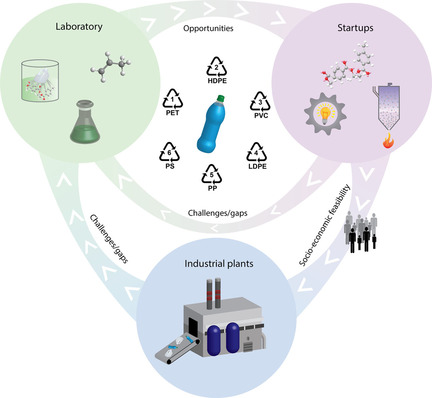Purified recycled materials are referred to as mixed plastics. Because mixed plastics are a blend of many plastic kinds, they have varying processing performance and stability, which frequently results in aberrant processing temperature and processing time. The processing stability and thermal stability need to be adjusted. steady operation.
Because polymers with various structural characteristics are often incompatible from a thermodynamic perspective, they cannot combine uniformly. The continuous phase is made up of the polymer with the highest content, while the polymer with a lower content is distributed within it. However, there is very little intermolecular interaction between the continuous phase and the scattered phase, which causes the composite's mechanical characteristics to decline. Compatibilizers must be used in raw and recycled material combinations in order to enhance their mechanical qualities.
The compatibilizer can enhance the polymer's interfacial properties, lower interfacial tension in the liquid state, stabilize the dispersed phase to avoid aggregation during cooling, increase the force at the interfaces between the phases, and achieve the least amount of phase separation in the solid state to avoid delamination. The ideal compatibilizer should be able to accomplish the optimal fusion of various surfaces depending on the precise chemical makeup of the plastic. There are two categories of frequently used compatibilizers: reactive and non-reactive. In-situ compatibilizers can be formed by reactive monomers.
Examples of Recycled Plastic Compatibility
Peroxide can enhance the material's mechanical characteristics in situ, but the effect is only temporary. After extrusion, the impact strength of PE/PVC combinations improves due to crosslinking/branching reactions caused by the addition of reactive monomers or coupling agents, such as adding benzoyl peroxide to maleic anhydride. Similar to this, adding 0.5-1.0% of 2,5-dimethyl-2,5-bis(butyl peroxide)hexane can alter the morphology of mixed polymers made of PE, PP, PVC, PS, and PET while also enhancing their mechanical qualities (mostly unnotched impact strength). Compatibility research with unsaturated polyesters and peroxide compounds has also proven fruitful.
In order to increase the PA/PP mixture's Izod impact strength and tensile elongation, recycled PP can immediately react with maleic anhydride under the influence of peroxide. Studies reveal that two alternative compatibilizers, maleic anhydride grafted PP and styrene-acrylonitrile-glycidyl methacrylate copolymer, may successfully provide in-situ compatibilization with PP/ABS combination.
Copolymers created by mixing ethylene and propylene monomers can make PP/HDPE blends compatible; add 5% copolymers (6% PE) to blends of 30% recycled HDPE and 70% new PP for the greatest mechanical qualities (see table 25).

The primary purpose of mixing various plastics is to investigate how household PVC, PS, and PET waste plastics disperse on polyolefin substrates. The results of the study show that the incompatibility of different mixing components significantly affects the impact strength, toughness, brittle transition temperature, elongation at break, and other properties of molding materials, but the addition of compatibilizers can significantly enhance the aforementioned mechanical properties.
Even mixed polymers that are brittle at 20 degrees Celsius may be converted into mixed materials with superior ductility below zero, and certain mixed materials have higher ductility even at -30 degrees Celsius. Although additions of 5–10% are necessary, styrenic block copolymers are the most intriguing compatibilizers. By adding compatibilizers, mixed materials are created with great homogeneity.
These results were also supported by research on the mixing of various packaging waste polymers. The flexural modulus, tensile strength, and heat deflection temperature (HDT) of the material can be increased by rigid compatibilizers based on styrene-maleic anhydride copolymer or phenoxy resin, however these properties come at the expense of the material's durability and elongation at break. Impact characteristics do have some impact. The elongation at break and impact resistance of the hybrid material can be improved by soft polymers like EPDM, SBR, and ethylene-methacrylate copolymer, although their effects are more noticeable on the material's tensile strength and flexural modulus.
Complexity of capacity growth
Compatibilizers have a stronger impact on recycled plastics' durability since they typically contain groups that are sensitive to heat, light, and oxidants. As a result, formula design must take this unique feature into consideration. One such is the PE/PA composite material used in food packaging bags.
Research is required to identify a technique that is suited for the compatibilization of mutually incompatible recycled plastics since conventional methods cannot be employed to distribute these composite films in the formulation's constituent parts. When compatibilizers are added, a plastic mix that may be used for extrusion and injection molding is created.
The artificial aging test, however, demonstrates that this blend's drawback is that it ages very easily, all of its mechanical and physical capabilities vanish very rapidly, and the plastic blend after compatibilization is more easily degraded than any of the raw materials in its composition. The testing findings are still unsatisfactory even if adding a HAS component to the mixture and compounding an adequate antioxidant can boost the light stability. The only way to considerably increase the performance of the mix is by appropriately adding zinc oxide to the recipe. improve.
Even after 8000 hours of artificial age, the performance test of the recycled plastic mix compatibilized with polyacrylic acid compatibilizer reveals that it practically preserves the original mechanical qualities.











